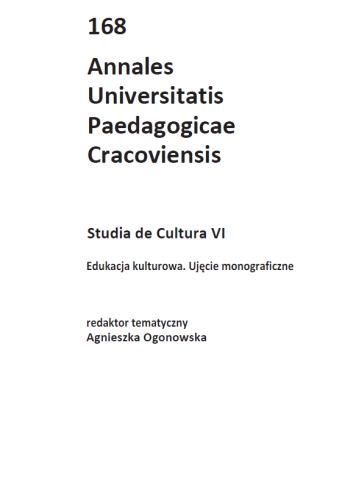Abstract
A few remarks on film education (in the context of the
culture of participation)
The article discusses the current condition of film education in schools, juxtaposed with characteristics of the culture of participation (the culture of taking part). Inadequacies of the classic model of film education can be overcome in teaching by highlighting media practices of young people. The use of their semiotic activity would have a great educational value, and at the same time it would foster the creation of a critical approach to forms of media presentations and of responsibility for the actions taken.
References
Bobiński W. (2011), Teksty w lustrze ekranu. Okołofilmowa strategia kształcenia literacko-kulturowego, Kraków.
View in Google Scholar
Couldry N. (2010), Media w kontekście praktyk. Próba teoretyczna, tłum. A. Strzemińska, „Kultura Popularna”, nr 1.
View in Google Scholar
Elsaesser T. (2012), Kinofilia albo pożytki z odczarowania, „Panoptikum”, nr 11(18).
View in Google Scholar
Gitelman L. (2011), Always Already New: Media, History and the Data of Culture, Cambridge: MIT Press, cyt. za: A. Lotz, Zrozumieć telewizję u progu ery postsieci [post-network era], [w:] Zmierzch telewizji? Przemiany medium. Antologia, red. T. Bielak, M. Filiciak, G. Ptaszek, Warszawa, s. 88–89.
View in Google Scholar
Jenkins H. (2007), Kultura konwergencji. Zderzenie starych i nowych mediów, Warszawa.
View in Google Scholar
Klejsa K. (2010), A film-like thing, czyli o tym, jak zjawiska filmopodobne utrudniają odpowiedź na pytanie: „co to jest film?”, [w:] Kino po kinie. Film w kulturze uczestnictwa, red. A. Gwóźdź, Warszawa.
View in Google Scholar
Filiciak M., Danielewicz M., Halawa M., Mazurek P., Nowotny A. (2010), Młodzi i media. Etnografia cyfrowego świata, „Kultura Popularna”, nr 1.
View in Google Scholar
Ogonowska A. (2013), Współczesna edukacja medialna. Teoria i rzeczywistość, Kraków.
View in Google Scholar
Rancière J. (2012), The Emancipated Spectator, „Art Forum” 2007, nr 3, cyt. za: G. Świętochowska, Od Redakcji. Widz – użytkownik – twórca, „Panoptikum”, nr 11(18), s. 7.
View in Google Scholar
Skowronek B. (2002), Wizja szkolnej edukacji filmowej, [w:] Wybrane zagadnienia edukacji polonistycznej, red. H. Kurczab, U. Kopeć, E. Kozłowska, Rzeszów.
View in Google Scholar
Skowronek B. (2004), Szkolna edukacja medialna – krajobraz po bitwie?, [w:] Edukacja medialna. Teksty i preteksty, red. I. Borkowski, Wrocław.
View in Google Scholar
Skowronek B. (2007), Edukacja filmowa, edukacja medialna – propozycje dydaktyczne, [w:] tenże, Konceptualizacje filmu i jego oglądania w języku młodzieży. Studium kognitywno-kulturowe, Kraków.
View in Google Scholar
Skowronek B. (2008), Jak filmoznawca może pomóc szkolnemu poloniście w interpretowaniu tekstów kultury, „Polonistyka”, nr 2.
View in Google Scholar
Skowronek B. (2009), Analiza filmowych tekstów kultury (w kontekście nowej podstawy programowej), „Zeszyty Szkolne. Edukacja Humanistyczna”, nr 4.
View in Google Scholar
Skowronek B. (2010), Jak dzisiejsza młodzież interpretuje dzieła filmowe. Wnioski dla dydaktyki polonistycznej, „Annales Universitatis Paedagogicae Cracoviensis. Studia at Didacticam Litterarum Polonarum et Linguae Polonae Pertinentia I", Kraków 2010.
View in Google Scholar
Walczak A. (2010), Dlaczego warto z uczniami analizować i interpretować filmy?, [w:] Filmoteka Szkolna. Scenariusze zajęć i materiały pomocnicze dla nauczycieli, red. M. Hajdukiewicz, S. Żmijewska-Kwiręg, Warszawa.
View in Google Scholar
Żaglewski T. (2012), Kultura postkinowa, czyli widz w dobie multipleksów, „Panoptikum”, nr 11(18).
View in Google Scholar

